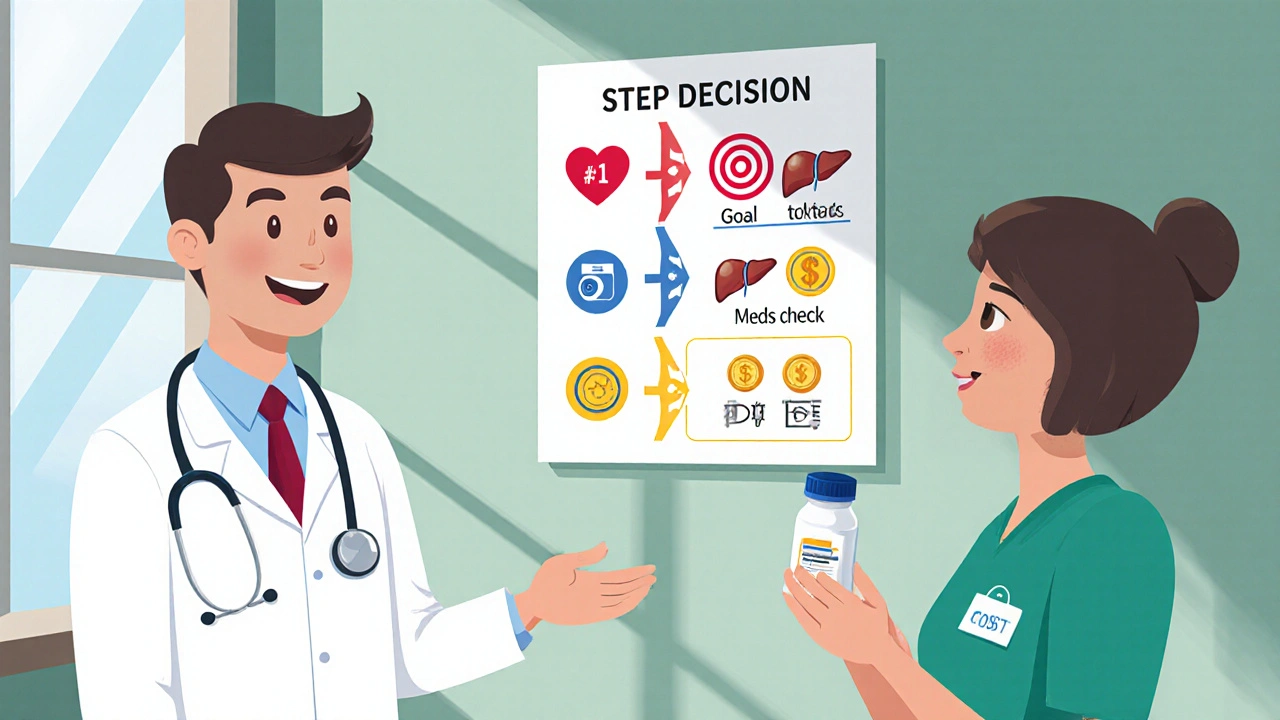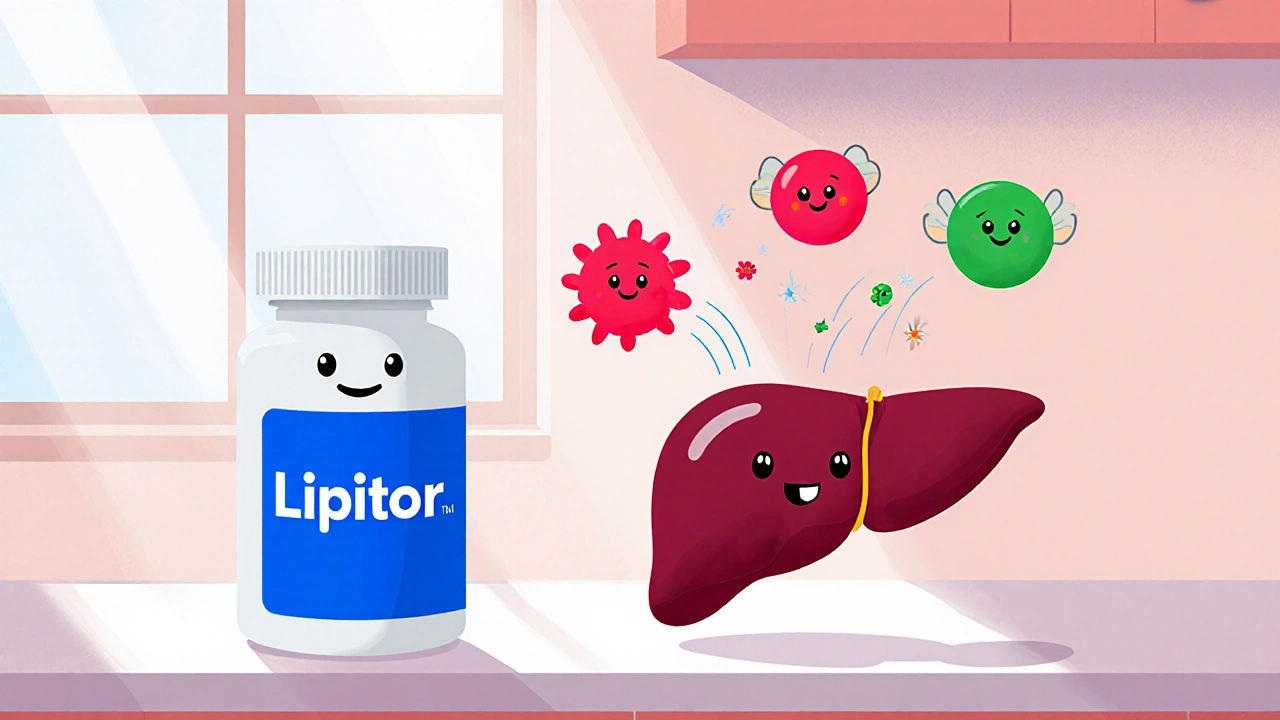Statin Effectiveness Calculator
Find the Statin That Meets Your LDL Reduction Goal
Results
Enter your target LDL reduction percentage to see which statins can achieve it.
If you’ve been prescribed a cholesterol‑lowering pill, you’ve probably heard the name Lipitor. But you might wonder whether another statin could work better for your budget, lifestyle, or side‑effect profile. This guide breaks down Lipitor (generic name Atorvastatin) and puts it side‑by‑side with the most common alternatives, so you can see the real differences and decide what fits you best.
What Lipitor (Atorvastatin) Actually Is
Lipitor (generic name Atorvastatin) belongs to the class of drugs called statins. It works by inhibiting the enzyme HMG‑CoA reductase, which the liver uses to make cholesterol. The result is lower LDL cholesterol (the “bad” kind) and a modest rise in HDL cholesterol (the “good” kind).
Typical doses range from 10 mg to 80 mg once daily, taken with or without food. The drug’s potency makes it a go‑to choice for patients needing a big drop in LDL - often 30‑50 % or more, depending on dose and baseline levels.
Key Attributes of Lipitor
- Effectiveness: One of the strongest statins on the market; can lower LDL by up to 55 % at the highest dose.
- Common side effects: Muscle aches (myalgia), occasional liver‑enzyme elevation, and rare cases of rhabdomyolysis.
- Drug interactions: Notable with certain antibiotics (clarithromycin), antifungals (ketoconazole), and grapefruit juice - all can raise blood levels.
- Cost: Brand name Lipitor is pricey (£30‑40 per month in the UK), but the generic Atorvastatin is usually under £5.
- Monitoring: Baseline liver function tests, then repeat after 6‑12 weeks; periodic CK (creatine kinase) checks if muscle symptoms appear.
Statin Alternatives Worth Looking At
While Lipitor is strong, other statins may be better suited for specific scenarios - such as lower cost, fewer drug interactions, or a gentler side‑effect profile. Below are the four most prescribed alternatives.
Simvastatin (Zocor) is a mid‑potency statin often used when moderate LDL reductions are enough. It’s cheap and comes in 5 mg, 10 mg, 20 mg, 40 mg, and 80 mg tablets, but the 80 mg dose is limited to patients with very high risk.
Rosuvastatin (Crestor) rivals Lipitor in potency but has a longer half‑life, allowing for more flexible dosing. It’s also less affected by CYP3A4 interactions, which can be a plus for patients on multiple meds.
Pravastatin (Pravachol) is the most hydrophilic statin, meaning it stays largely in the liver and has fewer muscle‑related complaints. It’s often chosen for older adults or those with a history of statin intolerance.
Fluvastatin (Lescol) offers modest LDL reductions (about 20‑30 %) and is another option for patients who can’t tolerate stronger drugs.
Side‑Effect Profiles Compared
All statins share a core set of possible adverse events, but the frequency and severity can differ. Here’s a quick snapshot:
- Muscle pain: Most common with high‑dose Lipitor and Simvastatin; lower with Pravastatin.
- Liver enzyme rise: Slightly higher incidence in Rosuvastatin.
- Drug interactions: Simvastatin is heavily metabolized by CYP3A4, so it clashes with many antibiotics and antifungals. Lipitor also uses CYP3A4 but is a bit more forgiving.
- Diabetes risk: All statins carry a modest increase in new‑onset type 2 diabetes; the risk scales with dose, so low‑dose options like Fluvastatin may be preferable for pre‑diabetic patients.
Head‑to‑Head Comparison Table
| Attribute | Lipitor (Atorvastatin) | Simvastatin | Rosuvastatin | Pravastatin | Fluvastatin |
|---|---|---|---|---|---|
| Typical Dose Range | 10‑80 mg daily | 5‑80 mg daily | 5‑40 mg daily | 10‑80 mg daily | 20‑80 mg daily |
| LDL Reduction (average) | 30‑55 % | 20‑45 % | 35‑55 % | 20‑30 % | 20‑30 % |
| Cost (UK generic, per month) | £5‑10 | £2‑5 | £6‑12 | £3‑6 | £3‑7 |
| Key Side‑Effects | Myalgia, liver enzyme rise, rare rhabdo | Higher myalgia risk at >40 mg | Potential liver impact, mild myalgia | Lowest muscle complaints | Generally mild |
| Major Drug Interactions | CYP3A4 inhibitors (e.g., clarithromycin) | Many CYP3A4 inhibitors, gemfibrozil | Fewer CYP interactions, watch for colchicine | Minimal CYP involvement | Limited, but avoid strong CYP2C9 inhibitors |

How to Choose the Right Statin for You
Picking a statin isn’t a one‑size‑fits‑all decision. Use the following three‑step checklist to land on the best option.
- Assess your risk goal: If your doctor aims for a >50 % LDL drop (e.g., after a heart attack), Lipitor or Rosuvastatin are strong picks. For moderate risk, Simvastatin or Pravastatin may suffice.
- Review current meds and health conditions: If you take multiple CYP3A4‑metabolized drugs, avoid high‑dose Simvastatin. If you have liver disease, Pravastatin’s safer profile helps.
- Factor in cost and convenience: Generic Atorvastatin is cheap, but if you need a low dose because of diabetes risk, Fluvastatin’s modest potency can keep expenses down.
After you narrow down a candidate, start with the lowest effective dose and schedule a follow‑up lipid panel in 6‑8 weeks. Adjust up or down based on results and tolerance.
When to Talk to Your Doctor
Even the best statin can become a problem if it’s not monitored. Reach out if you notice any of these red flags:
- Unexplained muscle soreness that persists for more than a week. \n
- Dark urine or a sudden drop in energy (possible rhabdomyolysis).
- Yellowing of the skin or eyes (liver issues).
- Significant, unexplained weight loss or changes in blood sugar.
Timely communication can prevent serious complications and often leads to a simple dose tweak or a switch to a better‑tolerated alternative.
Frequently Asked Questions
Is Lipitor the same as Atorvastatin?
Yes. Lipitor is the brand name; Atorvastatin is the generic name. Both contain the identical active ingredient and work the same way.
Can I switch from Lipitor to another statin without a doctor's approval?
No. Statins differ in dosage, potency, and interaction risk. Your doctor should guide a safe transition and arrange follow‑up blood tests.
Which statin is cheapest in the UK?
Generic Atorvastatin and Simvastatin are typically the most affordable, often costing under £5 per month when purchased through the NHS or a standard pharmacy.
Do statins raise blood sugar?
All statins carry a modest risk of increasing fasting glucose, especially at higher doses. Monitoring your sugar levels is wise if you’re pre‑diabetic.
What should I do if I get muscle aches on Lipitor?
First, contact your doctor. They may order a CK test, lower the dose, or switch you to a statin with a lower muscle‑pain profile like Pravastatin.


Comments (11)
kendra mukhia
October 18, 2025 AT 22:11I cannot believe the sheer amount of nuance hidden in this guide-most people skim past the devilish details! The way it dissects Lipitor’s potency versus cheaper generics is practically a drama in drug form. You’ve got to appreciate the meticulous breakdown of CYP3A4 hellscape, especially the grapefruit‑juice warning. Also, the cost comparison table is a lifesaver for anyone who’s ever stared at a pharmacy receipt in horror. In short, this isn’t just another bland medical blurb; it’s a masterclass in statin strategy.
Bethany Torkelson
October 19, 2025 AT 23:11Reading this made my blood pressure spike-literally! The blood‑sugar risk section hit me like a punch to the gut, and I’m furious that doctors sometimes downplay it. If you’re on a high‑dose Lipitor and start feeling muscle pain, don’t wait for a “nice” follow‑up; call your doc now. This guide finally gave voice to the silent panic many of us feel when our meds turn into ticking time bombs.
Grace Hada
October 21, 2025 AT 00:11Statins aren’t all the same; choose wisely. Lipitor’s heft can be overkill for low‑risk patients.
alex montana
October 22, 2025 AT 01:11Wow!!! This guide?? It’s like a rollercoaster–of info?? Really, the drug‑interaction list? Mind‑blowing… but also terrifying??
Just read it, and you’ll never look at your pill bottle the same way again.
Wyatt Schwindt
October 23, 2025 AT 02:11Thanks for the clear rundown. I appreciate the practical tip about starting low and checking labs in 6‑8 weeks. It makes the whole process feel less intimidating.
Avril Harrison
October 24, 2025 AT 03:11Interesting read, thanks!
Sarah Hanson
October 25, 2025 AT 04:11Dear author, I must say this article is exceptionally thorough and well‑structured. The comparative table is particularly helpful for clinicians and patients alike. However, I noticed a minor typo-“definately” should be “definitely.” Overall, your work is commendable and surely will aid many in making informed decisions.
Nhasala Joshi
October 26, 2025 AT 05:11The moment I opened this guide I sensed a hidden agenda lurking behind the glossy stats. Why does the industry love to push Lipitor like it’s the holy grail of cholesterol control? It’s no coincidence that the pharmaceutical giants own the patents on the most potent statins. They whisper sweet promises of heart‑health while secretly inserting micro‑chips into the pill coating, a fact that most mainstream doctors won’t dare mention. 👀 Have you ever noticed the sudden rise in “designer” statins that claim fewer side‑effects? That’s just a smokescreen to keep us dependent on a handful of conglomerates. The table showing cost differences is a clever diversion; you’re too busy comparing pennies to see that the real price is your autonomy. And the mention of grapefruit juice? That’s a nod to the old pharmacology hack that regulators can’t officially endorse. Everyone talks about muscle aches, but they never discuss the subtle cognitive fog that some patients report after months of high‑dose therapy. The risk of new‑onset diabetes is downplayed, yet epidemiologists have linked statin use to a steady climb in insulin resistance worldwide. I suspect the “monitoring” recommendation is just a way to get us into the lab more often, feeding data back to the drug companies. If you read between the lines, the guide subtly nudges you toward Atorvastatin because it’s the most profitable for the parent corporation. The alternative statins are presented as “cheaper,” but in reality they’re a way to keep the market fragmented and the consumer confused. Bottom line: stay vigilant, question every “clinical guideline,” and consider lifestyle changes that make statins unnecessary. 🌐 Stay safe, fellow seekers of truth, and keep sharing the hidden knowledge!
Brian Van Horne
October 27, 2025 AT 06:11Your conspiracy narrative is certainly colorful, yet the pharmacological evidence remains straightforward. Lipitor's efficacy and risk profile are documented in peer‑reviewed journals, not in secret dossiers. While grapefruit interactions are real, they stem from well‑known CYP3A4 metabolism, not covert implants. Assessing statin choice should rely on clinical data, patient tolerance, and cost, rather than shadowy agendas. Nonetheless, staying critical is never a bad habit.
Norman Adams
October 28, 2025 AT 07:11Ah, the classic 'statins are a plot' routine-how original. If only we all had the time to decode micro‑chips while juggling cholesterol numbers. Perhaps next you’ll tell us the coffee in the break room is also laced with nanobots.
Margaret pope
October 29, 2025 AT 08:11I see where you’re coming from and appreciate the humor. Let’s keep the discussion factual and supportive.